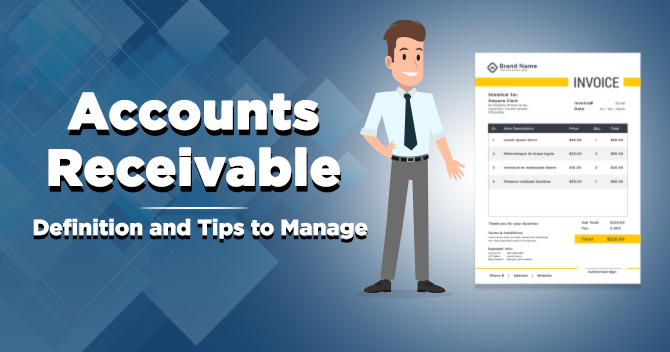Accounts receivable
Accounts receivable

Definition:
Accounts receivable are the funds that customers owe your company for products or services that have been invoiced. The total value of all accounts receivable is listed on the balance sheet as current assets and include invoices that clients owe for items or work performed for them on credit
- Accounts receivable (AR) is an asset account on the balance sheet that represents money due to a company in the short term.
- Accounts receivable are created when a company lets a buyer purchase their goods or services on credit.
- Accounts payable are similar to accounts receivable, but instead of money to be received, they are money owed.
- The strength of a company’s AR can be analyzed with the accounts receivable turnover ratio or days sales outstanding.
- A turnover ratio analysis can be completed to have an expectation of when the AR will actually be received.
Accounts Receivable vs. Accounts Payable
When a company owes debts to its suppliers or other parties, these are Accounts Payable. Accounts payable are the opposite of accounts receivable. To illustrate, imagine Company A cleans Company B’s carpets and sends a bill for the services. Company B owes them money, so it records the invoice in its accounts payable column. Company A is waiting to receive the money, so it records the bill in its accounts receivable column.
Benefits of Accounts Receivable:
1. Improve operational efficiency
Invoice generation and processing can be a complex process for some businesses, with multiple steps and sign-offs required to create and issue the invoice. Once generated, invoices need to be sent to the appropriate customer, who then needs to process it on their end before paying. Ideally, this process would be completed in a matter of hours, but it often takes days. Automating your accounts receivable reduces the number of steps involved and enables you to complete them faster.
Not only will automation improve the speed your accounts receivable are processed at, but it will also reduce the scope for human error and lead to much more reliable accounting. You won't need to wait around for invoices to be manually approved, you can be certain that your accounts receivable automation software is filling in the necessary details correctly without any human intervention.
By automating the accounts receivable process, you free up precious time and resources that can be deployed more effectively elsewhere. Creating and distributing invoices is a necessary process for any business, but you don't want it to take up more time than necessary.
2. Streamline invoice creation and get paid faster
Once you've completed work for a client, you will want to get paid as soon as possible. Delays in the payment process can have knock-on effects for the rest of your business and operations, so getting paid promptly is important. Any slowdowns in creating or processing invoices will mean you need to wait longer to receive payment for any work you've done. Our award-winning Spindle Document Management software makes it easy to generate paperwork and distribute it to recipients automatically. Whether you're creating documents from scratch or generating them automatically, having the right software solution available to manage and distribute them is essential.
Manually produced invoices are prone to errors. All it takes is one incorrect digit, and suddenly invoices can't be processed until they've been corrected. Every error adds time to the process and delays the point at which you receive payment for the work you've done. Data entry errors and organizational issues are common causes of delays in invoice processing. Automating the accounts receivable process reduces the error rate and ensures you're paid as quickly as possible.
3. Reduce your costs

One of the most compelling reasons for businesses to automate some or all of their operations is the potential cost savings. In today's hyper-competitive business environment, businesses need every advantage they can get to survive and excel beyond their competitors. Consumers have higher demands than ever before and more choice than ever about which businesses they turn to in order to meet those demands. Any business that wants to remain competitive needs to eliminate inefficiencies and reduce unnecessary expenditure.
Manually generating and processing invoices is much more costly than producing them automatically. Not only is the manual way more expensive, but it also takes up more employee time than overseeing an automated process. With the right automation software on your side, you can significantly reduce the amount of time you spend on your accounts receivable, and therefore minimize your administration costs.
As a business grows, getting paid often becomes more expensive as administration costs rise. Automating processes like the accounts receivable enables businesses to minimize these costs, whether they're just starting out or they've grown into a large corporation.
4. Improve your customer experience
The easier you make it for your customers to pay you once work is completed, the faster they will do so. A long and convoluted payments process will only harm your business and put customers off using you in the future. Providing accurate invoices as promptly as possible after delivering work to customers enables them to stay on top of their own accounting and positions your business as a reliable partner, not just a service provider. Delivering accurate invoices in a timely manner is an important component of an overall strategy for encouraging clear communications with your clients. Customers place enormous value in businesses that are upfront, honest, and easy to work with.
By automating your accounts receivable, you enable a consistent timeline from the delivery of services to the collection of payment. Your customers will appreciate consistency and reliability, both of which are easier with automation.
5. Improve employee retention
As your business grows and your operations become more complex, your finance team will come to play an increasingly critical role in keeping the ship afloat. As with any employees, the more they enjoy their job, the more likely they will stick with your business for the long run.
While your business is still relatively small, you will likely handle most of the accounting work yourself. However, as your business grows and you start handling more accounts, managing everything manually becomes significantly more challenging. Bringing in dedicated accounting staff is a smart and necessary move. But if they are over-worked and stressed out because you aren't providing them with the tools they need to do their jobs, your accountants will never produce the kind of results you're hoping for.
Automation means you need to hire less staff and that those you do hire have a much more positive experience working for you. As a result, they will stay with your business for longer.
Example:
An example of a common payment term is Net 30 days, which means that payment is due at the end of 30 days from the date of invoice. The debtor is free to pay before the due date; businesses can offer a discount for early payment. Other common payment terms include Net 45, Net 60, and 30 days end of month. The creditor may be able to charge late fees or interest if the amount is not paid by the due date.
Booking a receivable is accomplished by a simple accounting transaction; however, the process of maintaining and collecting payments on the accounts receivable subsidiary account balances can be a full-time proposition. Depending on the industry in practice, accounts receivable payments can be received up to 10–15 days after the due date has been reached. These types of payment practices are sometimes developed by industry standards, corporate policy, or because of the financial condition of the client.
Since not all customer debts will be collected, businesses typically estimate the amount of and then record an allowance for doubtful accounts which appears on the balance sheet as a contra account that offsets total accounts receivable. When accounts receivable are not paid, some companies turn them over to third party collection agencies or collection attorneys who will attempt to recover the debt via negotiating payment plans, settlement offers, or pursuing other legal action.
Conclusion
Outstanding advances are part of accounts receivable if a company gets an order from its customers with payment terms agreed upon in advance. Since billing is done to claim the advances several times, this area of collectible is not reflected in accounts receivables. Ideally, since advance payment occurs within a mutually agreed-upon term, it is the responsibility of the accounts department to take out the statement showing advance collectible periodically and should be provided to sales & marketing for collection of advances. The payment of accounts receivable can be protected either by a letter of credit or by Trade Credit Insurance.



